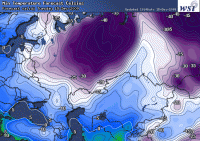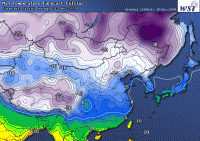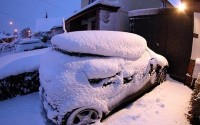Rionovosti
Russia affected by Climategate
A discussion of the November 2009 Climatic Research Unit e-mail hacking incident, referred to by some sources as “Climategate,” continues against the backdrop of the abortive UN Climate Conference in Copenhagen (COP15) discussing alternative agreements to replace the 1997 Kyoto Protocol that aimed to combat global warming.
The incident involved an e-mail server used by the Climatic Research Unit (CRU) at the University of East Anglia (UEA) in Norwich, East England. Unknown persons stole and anonymously disseminated thousands of e-mails and other documents dealing with the global-warming issue made over the course of 13 years.
Controversy arose after various allegations were made including that climate scientists colluded to withhold scientific evidence and manipulated data to make the case for global warming appear stronger than it is.
Climategate has already affected Russia. On Tuesday, the Moscow-based Institute of Economic Analysis (IEA) issued a report claiming that the Hadley Center for Climate Change based at the headquarters of the British Meteorological Office in Exeter (Devon, England) had probably tampered with Russian-climate data.
The IEA believes that Russian meteorological-station data did not substantiate the anthropogenic global-warming theory. Analysts say Russian meteorological stations cover most of the country’s territory, and that the Hadley Center had used data submitted by only 25% of such stations in its reports. Over 40% of Russian territory was not included in global-temperature calculations for some other reasons, rather than the lack of meteorological stations and observations.
The data of stations located in areas not listed in the Hadley Climate Research Unit Temperature UK (HadCRUT) survey often does not show any substantial warming in the late 20th century and the early 21st century.
The HadCRUT database includes specific stations providing incomplete data and highlighting the global-warming process, rather than stations facilitating uninterrupted observations.
On the whole, climatologists use the incomplete findings of meteorological stations far more often than those providing complete observations.
IEA analysts say climatologists use the data of stations located in large populated centers that are influenced by the urban-warming effect more frequently than the correct data of remote stations.
The scale of global warming was exaggerated due to temperature distortions for Russia accounting for 12.5% of the world’s land mass. The IEA said it was necessary to recalculate all global-temperature data in order to assess the scale of such exaggeration. In the IEA report there is a chart that shows that CRU’s selective use of 25% of the data created 0.64C more warming than simply using all of the raw data would have done. Given the huge area Russia represents, this significantly affects global land temperatures.
Global-temperature data will have to be modified if similar climate-date procedures have been used from other national data because the calculations used by COP15 analysts, including financial calculations, are based on HadCRUT research.
RIA Novosti is not responsible for the content of outside sources. Read story here. H/T Roger Pielke Sr. See PDF here.
ICECAP NOTE: recall it is in Soviet Union that the CRU, NOAA, NASA show the greatest warming. As this story implies, there was no obvious reason for these data centers to be selective about stations. It implies the stations often selected were urban and those with incomplete data, providing more opportuniuty for mischief.
See more here
See still more coverage here in the Daily Express.
---------------------------------
Extreme Cold Becoming Widespread - North America, China, Russia and Europe
Edmonton shatters cold record
Edmonton Journal
Edmonton’s weather boasted two dubious distinctions Sunday: it was colder here than anywhere else in North America and it marked the coldest Dec. 13 in the city’s history. Environment Canada recorded a frigid minus 46.1 C (-51F), or minus 58.4 C with the wind chill, at the Edmonton International Airport at 5 a.m., said meteorologist Pierre Lessard. The old record of minus 36.1 C was set last year.
“To break a temperature by 10 degrees C (19F) is very exceptional,” said Lessard. The temperature record from Edmonton’s city centre was also broken Sunday, said meteorologist John McIntyre. Environment Canada recorded a temperature of minus 36.5 C downtown at 8 a.m. Sunday, beating the previous record for the day of minus 32.8 C in 1882, McIntyre said.
While Edmontonians may be wishing the weather gods would be a little less ambitious, there was at least one person in the city who could still see beyond the horrifying numbers on the thermometer. “(Sunday) it was beautiful with the hoar frost on all the trees and the light was really misty,” said Pamela Anthony, director of the Winter Light festival, a civic celebration of winter which launched last January and will run again from Jan. 6 to March 13 next year.

“It was almost cinematic. But it is hard to see if you are distracted by discomfort. The cold can be pretty intimidating. This is serious weather. You are a membrane of glass away from disaster and deep down, we all know it.”
But Edmonton is a winter city, and if last’s year launch was any indication, Edmontonians know how to embrace the cold and even thrive in it, she said. “Last year’s opening in January was very much like this. It was very cold. It was that it’s ‘too cold’ cold. We were so surprised that people came out and were cold with us.” People stuck it out in Churchill Square for a long time, taking in the outdoor blessing and watching artists perform before the event finally moved inside. “It was quite wonderful in that beautiful, odd Edmonton way,” Anthony said.
The city’s longest cold snap was in 1969 when the temperature never got warmer than -20 C for 26 consecutive days. The Journal handed out certificates to survivors.
Some flights scheduled to land at the Edmonton International Airport late Saturday night and early Sunday morning were diverted to Calgary because of the severe temperatures, said Edmonton International Airport spokeswoman Traci Bednard. There were some delays and a couple of cancellations for flights departing Edmonton as well on Sunday morning because of the cold, she said. “Different airlines and aircraft have different operating limits,” Bednard said.
The wait time for a tow truck in Edmonton on Sunday was 24 hours and eight hours for a light service call, said Alberta Motor Association spokesman Kent Dixon. The majority of light service calls have been for boosts, Dixon said. “Below -15 is when you should be plugging (your car) in. It’s absolutely necessary, it’s not a question,” he said. Even if people don’t plan on going outside in between parking cars in two heated garages, people should always dress for outside conditions, Dixon said. “It’s really severely cold out right now, and if, for whatever reason, you get stuck or have to wait in a vehicle or get out, you’re going to be thankful pretty quickly that you were dressed appropriately for outside temperatures,” Dixon said.
He recommends keeping a blanket and an emergency kit in all vehicles. “Act accordingly, be prepared and don’t put your safety at risk,” he said. See more here.
----------------------------
Delegates freeze as snow falls on global warming debates
By Cathy Alexander, Sydney Morning Herald
World leaders will meet to tackle global warming - in the snow. The temperature in Copenhagen, where a landmark UN summit on climate change is taking place, is tipped to hit minus ten degrees Celsius this week. Snow is expected to start falling and continue through to the last day of the summit on Friday.
A white Christmas may please Denmark’s children but Copenhagen in the depths of winter is an odd setting to highlight the dangers of a warming world. Delegates from Africa, Asia and the Pacific are struggling with the freezing conditions. Some do not have the right clothes and are trying to minimise their time spent outside this week. Why UN organisers selected Copenhagen for the December summit remains a mystery. They might have had more success in drawing attention to the perils of hot weather if they had chosen Perth, where the temperature is forecast to reach 37 degrees this week, or Canberra where it will be 36.
A central issue at the summit is whether global warming should be limited to 1.5 degrees or 2 degrees. But some delegates are saying that Copenhagen in December might be more pleasant if it was about 15 degrees warmer. Copenhagen is also being criticised as the summit venue by delegates because it is very expensive. A cappuccino costs $A5, a beer at least $7, a small hot dog from a street stand $8, and a “cheap”, simple lunch dish can easily cost $30. Clothes are also expensive, making it difficult for delegates from the developing world to buy gear for the cold snap. Read more here.
Icecap Note: Over the next few weeks, very cold temperatures and snow will be in the news across southern Canada, the United States, Europe, the FSU and much of China. This was expected as a stratospheric warming event last few weeks led to building arctic high pressure now pressing south.

Today’s lows in Russia (degrees celsius), enlarged here.

Next Monday’s lows in China (degrees celsius), enlarged here.

Next Sunday’s lows in Europe (degrees celsius), enlarged here.

Snow on Friday in Colchester, Essex in England.
Model imagery available from WSI here.
Last week was a truly memorable one too with a record breaking snow and cold outbreak. See summary of the many records set here.
-------------------------
See Mann throw Colleagues Under the Bus on WAPO
By Roger Pielke Jr.
In today’s Washington Post, Michael Mann of Penn State University and CRU email fame, gives us some good news about climate science and some bad news about his colleagues.
The good news is that climate science in his view is not at all impeached by the release of the CRU emails.
The scientific consensus regarding human-caused climate change is based on decades of work by thousands of scientists around the world.
The bad news is that some of his colleagues exhibited “poor judgment”:
I cannot condone some things that colleagues of mine wrote or requested in the e-mails recently stolen from a climate research unit at a British university. . . Some statements in the stolen e-mails reflect poor judgment—for example, a colleague referring to deleting e-mails that might be subject to a Freedom of Information Act request—but there is no evidence that this happened. I doubt that Professor Mann will be getting many cheery Christmas cards from his CRU-email colleagues. See post and comments here.
------------------------
A Climategate Who’s Who
---------------------------
See Expert Videos
Craig Idso, CO2 Science
As representatives of the nations of the world meet in Copenhagen to attempt to restrict the use of energy produced from coal, gas and oil in the guise of fighting global warming, many scientists and scholars are expressing grave concerns about what they are trying to do. Recognizing these concerns, we have posted a series of YouTube video vignettes in which such scientists and scholars present the reasons behind them.
We invite you to view the videos and do all you can to inform the public about their presence. Each of the videos can be accessed from the CO2 Science website, from the CO2Science YouTube channel , and other locations across the Internet, such as here. A categorized-list of the videos we have posted is presented on these sites. Wise decisions are made only when all pertinent aspects of an issue are examined. It is our sincere hope that the information presented in these videos will elucidate important truths that are presently ignored. See four posted videso with Dr. Lindzen, Dr. Soon, John Coleman and Joe D’Aleo on KUSI’s web site here.
See also audio interviews with many scientists on Its Rainmaking Time here.
-------------------------
Urban vs Rural in US
A comparison of data from urban and rural sites to see if there is an Urban Heat Effect. Data from NASA GISS. Graphs made with Microsoft Excel.


